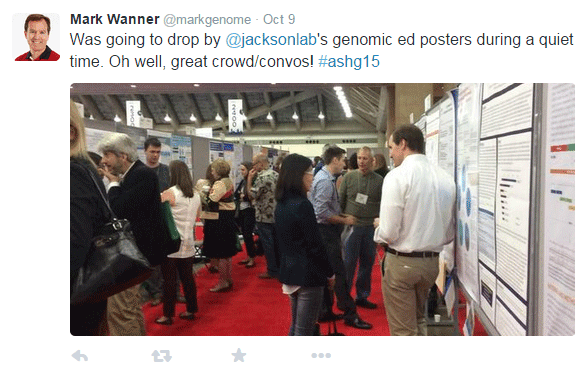The annual American Society for Human Genetics meeting, held last week (October 5-11) in Baltimore, can be overwhelming for first-time attendees. And so it was. The final person count approached 8,000 attendees and who knows how many speakers and vendors, and activities went from before dawn to well after dusk every day.
No matter what I did—and I did a lot—I felt like I was missing out on something even more important. And I probably was much of the time. But a few key themes emerged for me:
- The government’s Precision Medicine Initiative has changed the discussion, putting more pressure on implementation, but the same challenges (documented below) remain, making clinical implementation of genomics slow and painstaking.
- A couple of talk sessions showed vital and encouraging data on doctor support, delivery of sequencing findings to patients, economic impacts and more. Nonetheless, the reimbursement and regulation landscape remains fuzzy at best, and the U.S. healthcare system (including insurers and the FDA) remain unprepared to transition from a population average based medical system to a precision (individual) based model.
- Healthcare professionals know even less about genomics and its current and potential clinical applications than I thought. A huge amount of education is needed, which will also delay implementation.
- Concerns about negative patient impact from genome and exome sequencing are being proven unfounded. Researchers are studying what data to deliver—including about secondary findings—how to deliver it, how patients and their families react and how useful the data are. They find that while patients want choice, but given the choice almost all want to know as much as possible. And in a variety of settings, including pre-conception screening, they are able to process the information, including bad news, quite well.
- Data sharing, and the patient consent associated with it, remains extremely difficult, and there’s a need for positive incentives to generate a data commons framework. Adding to the challenge is our current (outdated) network of EMR systems. On the other hand, people are willing to share data when engaged—and more so after sequencing—but it’s a very labor-intensive process at this time.
- Of course research drives clinical progress, and the show offered new information about a dizzying number of genomic variants, including new data on previous variants of unknown significance (VUS). As a result, clinical reports are getting more robust all the time, which is great news. On the other hand, even as variants are better understood one by one, the findings underscore the massive amount of work still to be done, with thousands and thousands (Hundreds of thousands? Millions?) of variants remaining to be discovered and annotated. And for complex diseases, their interactions within the larger networks and systems must be characterized. Phew!
- Finally, at the technology level, there’s a sense that people are eager to jump on long-read sequencing if and when it becomes sufficiently accurate and economical. There were several talks that highlighted in passing some of the very real limitations of short-read sequencing, and it’s more and more apparent (at least to me) that long reads will do a lot to accelerate the generation of clinically relevant sequencing data.
In addition to learning a lot from the general talks, I had wonderful conversations with experts from the pharmaceutical industry, genomics education, the sequencing field and more. I also very much enjoyed a chance to gather off-campus with my JAX colleagues. It was great to see them giving talks and sharing posters, and for the first time the Lab hosted a reception to showcase our work.
Another theme from the conference was the need to do a better job of connecting patients with researchers. It’s vital to build pipelines for their data to inform experimental models, which in turn provide data that can go back to the clinic to inform patient care—bedside to bench to bedside, as it were. JAX is becoming more and more involved in the human genetics field, and ASHG helped showcase how it can serve as an epicenter for this kind of translational research. Its mouse model resources offer an unparalleled experimental system for researching the implications of data found in human sequences, an essential part of the bedside to bench to bedside capability.
The challenges for precision medicine remain significant on both the medical delivery side and the research side. Nonetheless I’m excited to see what the coming year brings and to revisit these themes and more at the next ASHG in Vancouver.
Mark Wanner followed graduate work in microbiology with more than 25 years of experience in book publishing and scientific writing. His work at The Jackson Laboratory focuses on making complex genetic, genomic and technical information accessible to a variety of audiences. Follow Mark on Twitter at @markgenome.



